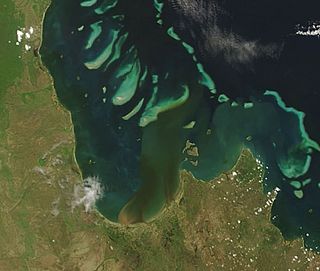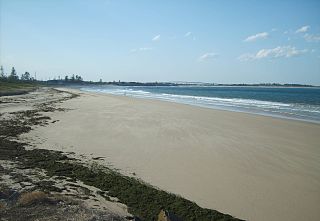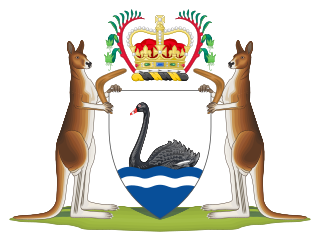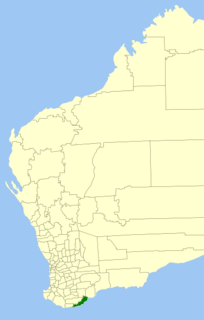
A shark attack is an attack on a human by a shark. Every year, around 80 unprovoked attacks are reported worldwide. Despite their relative rarity, many people fear shark attacks after occasional serial attacks, such as the Jersey Shore shark attacks of 1916, and horror fiction and films such as the Jaws series. Out of more than 489 shark species, only three are responsible for a double-digit number of fatal, unprovoked attacks on humans: the great white, tiger, and bull. The oceanic whitetip has probably killed many more castaways, but these are not recorded in the statistics.

Cottesloe is a western suburb of Perth, Western Australia, within the Town of Cottesloe. Cottesloe was named for Thomas Fremantle, 1st Baron Cottesloe, a prominent Tory politician and the brother of Admiral Sir Charles Fremantle for whom the city of Fremantle was named. The nearby suburb of Swanbourne was named for the Fremantle family seat, Swanbourne House, in Swanbourne, Buckinghamshire.

A shark net is a submerged net placed around beaches to reduce shark attacks on swimmers. The majority of Shark nets used are Gillnets which is a wall of netting that hangs in the water and captures the targeted sharks by entanglement. The nets in Queensland, Australia, are typically 186m long, set at a depth of 6 m, have a mesh size of 500 mm and are designed to catch sharks longer than 2m in length. Shark nets are not to be confused with shark barriers.

King George Sound is the name of a sound on the south coast of Western Australia. Originally named King George the Third's Sound, it was referred to as King George's Sound from 1805. The name "King George Sound" gradually came into use from about 1934, prompted by new Admiralty charts supporting the intention to eliminate the possessive 's' from geographical names.

Princess Charlotte Bay is a large bay on the east coast of Far North Queensland at the base of Cape York Peninsula, 350 km north northwest of Cairns. Princess Charlotte Bay is a part of the Great Barrier Reef Marine Park and it is a habitat for the dugong.

Middleton Beach is a coastal suburb of Albany, Western Australia, located within the City of Albany approximately 4 kilometres (2.5 mi) east of the city centre. The traditional owners, the Noongar peoples, know the place as Binalup meaning the place of first light since the sun rises over the waters in the morning. The main road between the city and the locality is via Middleton Road. It is home to a caravan park and numerous holiday units which provide accommodation for visitors to the Albany region.

Palm Cove is a beachside suburb of Cairns in the Cairns Region, Queensland, Australia. It is 27 kilometres (17 mi) north of the city of Cairns. It is named after the palm trees that line the beach.

Stockton Beach is located north of the Hunter River in New South Wales, Australia. It is 32 km (20 mi) long and stretches from Stockton, to Anna Bay. Over many years Stockton Beach has been the site of numerous shipwrecks and aircraft crash sites. In World War II it was fortified against a possible attack by Imperial Japanese forces. During that time it served as a bombing and gunnery range as well as a dumping area for unused bombs by aircraft returning from training sorties. The length of the beach, its generally hard surface and numerous items of interest along the beach make it popular with four-wheel drive (4WD) enthusiasts. Four-wheel drive vehicles are permitted to drive on Stockton Beach provided the vehicles are in possession of valid permits. The beach is also popular with fishermen and several different varieties of fish may be caught.
A drum line is an unmanned aquatic trap used to lure and capture large sharks using baited hooks. They are typically deployed near popular swimming beaches with the intention of reducing the number of sharks in the vicinity and therefore the probability of shark attack. Drum lines are often used in association with shark nets, with the intent of killing sharks. However SMART drum lines can be used to move sharks, which greatly reduces shark and bycatch mortality. The use of drum lines has been successful in reducing shark attacks in the areas where they are installed. The topic of shark culling became an international controversy and sparked public demonstrations and vocal opposition, particularly from environmentalists, animal welfare advocates and ocean activists.
Dean Cambell Nalder is an Australian politician who has been a member of the Legislative Assembly of Western Australia since 2013, representing the seat of Alfred Cove until 2017 and Bateman thereafter. He served as a minister in the government of Colin Barnett from March 2014 to September 2016.

Lipson Cove is a tranquil sandy bay in the Australian state of South Australia on the east coast of Eyre Peninsula overlooking Spencer Gulf. It features in the 2012 book 101 Best Australian Beaches by Andy Short and Brad Farmer.

The Albany Fish Traps, also known as the Oyster Harbour Fish Traps, are a series of fish traps situated in Oyster Harbour near the mouth of the Kalgan River approximately 14 kilometres (9 mi) east of Albany in the Great Southern region of Western Australia.

The Esplanade Hotel was a hotel that once stood overlooking Middleton Beach in Albany, Western Australia. The hotel was demolished in January 2007 by Singaporean owners, WCP Plaza, to make way for an 81-room hotel, function centre, village square, shops and health and recreation facilities. The proposal for the new hotel was approved in 2007 by the City of Albany. The Council also supported the rezoning of several locations in Earl Street and Barry Court to allow the development of the hotel. The site remains vacant in 2015.

Ellen Cove Jetty also known as Middleton Beach Jetty is a jetty found at the southern end of Middleton Beach in King George Sound in Albany in the Great Southern region of Western Australia.

The Eyre Park is a park in Middleton Beach in Albany in the Great Southern region of Western Australia.
Middleton Road is a significant arterial road in Albany, Western Australia.
There are a range of shark attack prevention techniques employed to reduce the risk of shark attack and keep people safe. They include removing sharks by various fishing methods, separating people and sharks, as well as observation, education and various technology-based solutions.

Shark culling is the deliberate killing of sharks by government authorities, usually in response to one or more shark attacks. The term "shark control" is often used by governments when referring to culls. Shark culling has been criticized by environmentalists, conservationists and animal welfare advocates — they say killing sharks harms the marine ecosystem and is unethical. Government officials often cite public safety as a reason for culling. The impact of culling is also minor compared to bycatch with 50 million sharks caught each year by the commercial fishing industry.

























